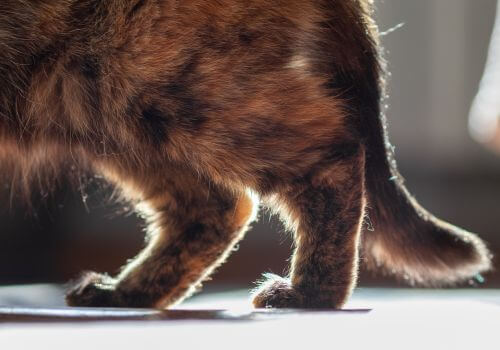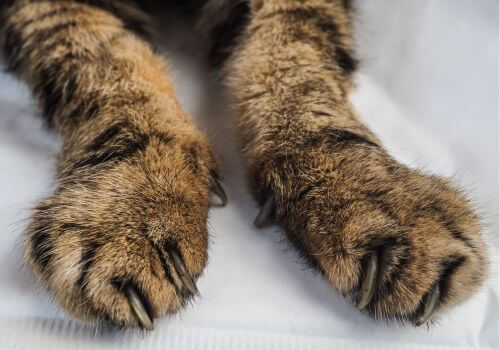There are a number of health conditions that can affect us humans as well as our animal companions, with arthritis being one of the most common. However, unlike us, our pets can't clearly express what's wrong or what kind of pain they're feeling. Cats especially are masters at hiding how they feel and masking symptoms of pain, making signs of conditions like arthritis in cats sometimes difficult for owners to recognize – especially if it's a low-level ache that's been there for a long time.
It's estimated that over 90% of cats over the age of 12 have arthritis. That means, if your cat is over 12, it's a good bet that they have arthritis too. With arthritis affecting such a large part of the feline population, it's important for cat owners to understand how arthritis affects a cat's body, how to recognize the signs of it, and how to help their cat manage the aches and pains associated with arthritis in cats.
How Do I Know If My Cat Has Arthritis?
First things first, let's talk about the basics of arthritis in cats. As our feline friends age, you might notice changes in both their behaviors and physical capabilities. They may not jump as well as they used to or sleep more than when they were kittens. While these changes can often be attributed to normal changes as a cat ages and enters their senior years, these behavior and activity changes could also be signs of arthritis.
Osteoarthritis is the technical term for what we typically just call arthritis in cats and even dogs. This condition is characterized by pain in the joints of the body, including the knees, hips, elbows, and back. We can diagnose arthritis based on physical examination findings and x-rays.

During a physical examination, a veterinarian will palpate your cat's joints to check for any signs of swelling, discomfort, or limited range of motion. If arthritis is suspected after the physical exam, most veterinarians will turn to X-rays to get visible confirmation of the presence of joint degeneration, bone spurs, or narrowing of joint spaces. X-rays may indicate extra bony growths along the joint – which indicate inflammation and the body's response to that inflammation or instability in the joint. All of these things lead to pain, which can greatly reduce your cat's comfort and quality of life.
Causes of Arthritis in Cats
While arthritis is most commonly seen in older cats due to the regular wear and tear on joints that occur throughout a cat's lifetime, that doesn't mean younger cats are exempt from the condition. Some cats may develop arthritis earlier in life, and this condition can be caused by a number of factors, including:
- Joint Abnormalities – Hip dysplasia, patellar luxation, and other abnormalities affecting the joints can contribute to early joint degeneration, and, thus, arthritis in cats.
- Injuries & Trauma – Fractures, dislocations, and ligament tears can all have lasting impacts on a cat's body, including their joints. When damaged, joints are more likely to become arthritic over time.
- Obesity and Body Conformation – The way a cat is built, as well as its weight, can influence the development of cat arthritis. Excess weight from obesity can put additional strain on a cat's joints, making normal bodily wear and tear occur faster, leading to earlier instances of arthritis.
- Autoimmune Disorders and Infections – Bacterial infections as well as immune-related conditions can be the root cause of inflammation that leads to arthritis.
- Previous Surgery – Orthopedic surgery from earlier in a cat's life can contribute to the development of arthritis due to changes in joint position or structure that may result from the procedure.
- Genetics & Breed Predisposition – Maine Coons, Scottish Folds, and Bengals are genetically predisposed to joint problems due to their anatomy. With the increased risk of joint issues, these breeds commonly see higher rates of arthritis.
How Do I Know If My Cat Has Arthritis Pain?

Once you know that your cat has arthritis or are starting to suspect that they do, here comes the tricky part: recognizing if your cat is in pain from arthritis. All cats with arthritis will experience some degree of pain, but the severity of it will depend on the individual cat, their overall health, and how much joint deterioration has occurred.
It's not easy to tell when a cat is in pain, so owners will need to pay close attention to their cat's behavior to determine if any deviations in their usual habits are something more than normal aging. Because every cat is different, there is no single factor a pet owner can look at to identify arthritis pain. Some cats may show subtle changes to their daily routines, while others may vocalize their pain or even show physical signs, like limping or refusing to put weight on certain limbs.
A few key signs of arthritis pain in cats to be on the lookout for include:
- Sleeping more
- Using their claws to pull up to their favorite high sleeping place
- Avoiding high sleeping places in favor of comfy lower sleeping spots
- Loss of muscle
- Limping
These signs are subtle, and you may need to talk with your veterinarian to assess your kitty fully. Then, x-rays will be the next step to see what's going on below the surface.
Treating Arthritis in Cats
Unfortunately, one size doesn't fit all when it comes to arthritis treatment for cats, and we often combine therapies to see what fits your cat the best and what is most effective at managing pain.
We often recommend supplements like glucosamine/chondroitin, Adequan, non-steroidal anti-inflammatory medications (NSAIDs), anti-nerve growth factor antibodies, and alternative therapies like therapeutic laser, acupuncture, and Boswellia supplements. Some of these treatments are off-label for cats, so it's important to talk with your veterinarian about what would be best for your individual cat.
The bottom line is that many cats suffer from arthritis that goes unnoticed. Our goal is to provide the best quality of life for your cat.
If you have questions and you'd like to reach out to us, you can call us directly at (949) 612-2756, or you can email us at [email protected]. Don't forget to follow us on social media Facebook, Instagram.
